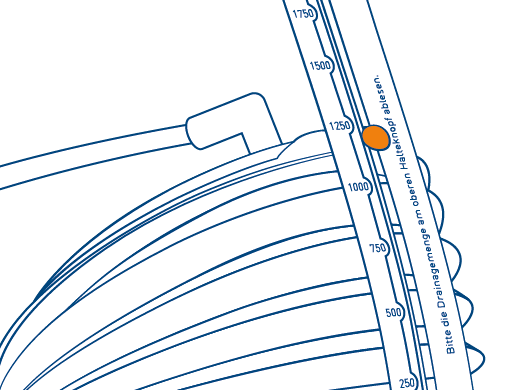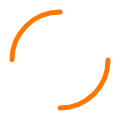Frequently asked questions (FAQ) from outpatient caregivers
Frequently asked questions (FAQ) from outpatient caregivers
Answers to frequently asked questions in the field of ambulatory care workers:
A total of two sutures must be removed. Usually this is done in the clinic where the implantation was done, but sometimes it is done directly by the patient’s family doctor. The skin thread after 7 – 10 days and the holding thread only after approx. 30 days.
For more information, see Removing the surgical stitches
After the catheter is properly covered with the foil dressing, your client can shower.
We recommend showering prior to drainage, as this allows for prompt dressing changes should the dressing become wet during showering.
As long as the catheter is functioning and no infection is evident, the catheter is not changed. However, contact the patient’s attending physician if you suspect anything.
To obtain the drainage material, your client will need a prescription from their primary care physician, as it is not available at medical supply stores or pharmacies, the prescription must be sent to us. For this purpose, postage-paid envelopes are available in the patient folder that your client received from our staff during training. You can find out more about this in the ewimed care concept.
If breathing problems persist after drainage has been completed, contact the attending physician or the implanting clinic for further clarification or diagnostics. The causes for this can be very different and depend on the individual course of the disease of your client.
The effusion color may change over time. From pale yellow to dark amber effusions; cloudy, milky effusions with or clear effusions without components are possible. Again, your client’s individual condition is the determining factor. If the effusions are bloody, the attending physician should be informed. The further procedure lies within the medical decision-making framework.
For proper performance of a dressing change in patients with catheters for drainage of pleural effusion or ascites, we have compiled a number of aids for you in the form of documents or training videos in our download area.
If you still have questions about this topic, please feel free to ask us in person.
How often the dressing needs to be changed in your patient with implanted catheter for drainage of pleural effusions and ascites depends, among other things, on the drainage interval. A dressing change is necessary after each drainage. Also after each shower, the dressing must be changed. From a hygienic point of view, we recommend changing the dressing every second day at the latest. In patients with a weeping wound, as is usually the case immediately after implantation, the dressing should be changed at least once a day.
We will be happy to assist you with advice.
No. The drainova® reservoir is equipped with a check valve. This effectively prevents effusion from flowing back at any time during drainage. During drainage, make sure that no pressure is applied to the reservoir.
No. The drainage scale serves as a stop element and prevents liquid from being drawn in beyond the maximum filling capacity of the drainova® reservoir. In addition, the integrated check valve effectively protects against overflow of drained effluent.
The drainage volume can be read at any time via the attached scale. The reading is taken from the upper retaining knob of the drainova® reservoir.
Do not read off the amount of liquid from the liquid level as you do with the PleurX™ bottles! The scale is calibrated for reading by means of the upper retaining knob.

Before emptying the drainova® reservoir, a new dressing should be applied over the catheter (see instructions for use). To empty the reservoir, proceed as follows:
- Place the reservoir on the floor. Open the pinch clamp and hold the hose up. Residual liquid can drain off through this.
- Close the pinch clamp.
- Cut the hose below the check valve.
- Hold the reservoir upside down and place the opening of the hose above the WC.
- By compressing the reservoir, the emptying process begins.
- When the reservoir is empty, attach the orange fuse and dispose of it in the plastic bag according to local regulations.
Note: In the case of known infectious pleural effusion or ascites, if disposal is not performed by the patient, the filled reservoir can be separately sealed in a garbage bag, disposed of in the residual waste after completion of drainage.
If effusion flow stops during drainage, several reasons may be the trigger. The most pleasant reason is that there is no more effusion. If this occurs more often, spontaneous pleurodesis may have occurred and the catheter can be removed. Another reason could be a blockage of the drainage tube, which is caused by a viscous or fibrinous effusion. In this case, you can try to mobilize the blockage by gently “rinsing” the drainage tube so that the effusion flows again, or the catheter must be flushed. For this you need to contact a doctor. You can read how the flushing process is performed here.
How can I “flush the catheter?”
In preparation, the catheter must be connected to a reservoir so that the blockage and any accumulation of effusion can drain directly. Put on disposable gloves and moisten them with hand sanitizer to allow the catheter to slide between your fingers. If large particles are visible, press them together. Then use one hand to hold the catheter near the exit site so that there is not much traction at the exit site. With the other hand, squeeze the catheter near the exit site and stroke it out in the direction of the safety valve. If nothing comes loose, repeat the procedure several times.
If there is pain when draining the fluid, stop the drainage using the clamp on the drainage tube and pause for a while. If the pain does not subside or recurs when the drainage is resumed, a physician should be consulted and possibly a change to another drainage option can be made.
If you have further questions or if the described answers are not suitable, please contact ewimed at any time at info@ewimed.com or +49 7471 73972-0. We will be happy to help you.
Do you have any further questions about our drainage systems, our service or our company?

